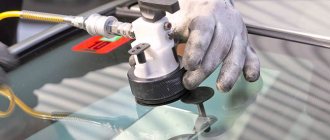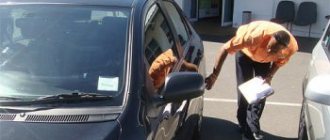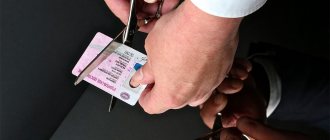Basic concepts about CASCO insurance policy
CASCO – voluntary insurance of a car against damage, loss or theft. If one of these events occurs, the insurance company compensates the victim for damage within the amount agreed upon in the contract. The policy may provide cash payment or in-kind compensation - repair or replacement of a specific part.
Under CASCO, unlike OSAGO, the driver insures his own property. Therefore, it does not matter who caused the accident. The main thing is that the policy owner fulfills the terms of the contract.
Attention! CASCO is a voluntary type of insurance. The driver has the right to enter into an agreement for any amount not exceeding the cost of the car and provide for a certain number of risks. CASCO can be paired with MTPL, but does not replace it.
How insurance cases are registered in CASCO
Each insurance company uses a specific template when drawing up a CASCO policy. However, each insurer has several of its own requirements, which are necessarily stipulated in the contract.
For example, it happens that the policy indicates that the car owner has every right to write an application for compensation and not provide any documents or certificates.
Then the insurer is obliged:
- eliminate the defect at your own expense;
- or immediately replace the damaged glass.
If the above clause of the contract is missing, then the owner of the vehicle, if damage occurs, should immediately contact the traffic police in order to draw up a protocol and obtain the necessary papers for the insurance company.
More than half of the CASCO policy contracts are drawn up by insurance agents with a restriction on the client’s request. That is, the insurance company introduces a limit on the number of glass replacements or repairs for one CASCO policy owner for a certain reporting period. Most often - within a year.
If there is damage to the car that exceeds the limit for claims to the insurance company, the owner of the car will have to fix the defect at his own expense. Naturally, you can also purchase an unlimited policy. But many car enthusiasts are put off by the cost of such a document.
Types of windshield damage
Even the most careful driver can break or damage the glass. CASCO insurance coverage includes the following damage to the windshield:
| Damage | Explanations |
| The battle | As a rule, in the event of a powerful impact, the windshield does not shatter into pieces, but is covered with a fine network of cracks and chips due to its multilayer structure. Repair in this case is impossible; replacement is necessary. Whether the insurance company will pay for it depends on the cause and nature of the damage. If the mechanical impact was directed from the street, this is almost always an insured event. |
| Chips | Chips are the result of mechanical impact on the glass. They come in different shapes: bull's eye, star, butterfly wings and so on. But almost all of them lead to cracks. Some insurers do not consider small single damage (up to 1–3 mm) as an insured event. Repair or replacement of glass under CASCO at RESO Guarantees and VSK due to chips is not carried out at all, unless they are accompanied by cracks. |
| Cracks | Cracks are thread-like, web-like or arc-shaped damage that grows over time. They often appear if chips are not repaired in time. An insured event is a crack that appears as a result of mechanical impact. The first sign of this is the presence of chips. If the glass is cracked due to the difference in temperatures in the cabin and outside or due to deformation of the body, the insurance company will not pay for its replacement. |
Other defects (scuffs and clouding, scratches) are not recognized by the insurance company as insurance. This is the result of natural wear and tear on the windshield.
What are the types of damage?
“If I take glasses from four different manufacturers, put them on the table and ask them to determine the best and the worst, a non-specialist will not do this.
Only installers will notice the difference. Of course, it’s good to work with original glass - it has all the seals, the edges are processed, even a primer is applied to the glass. But with Chinese or Russian it is more difficult, because there you need to reinstall everything.
This is also why it costs less.
In terms of glass quality, Yulia Malakhovskaya puts Belarusian and Russian manufacturers in last place. Chinese glass is of higher quality; Yulia recommends using it on commercial vehicles and for those who want to save a little money. There is also high quality Russian glass, which is produced near Nizhny Novgorod. But its price is twice as high as the Chinese one.
...the inspection of the car began: I examined it and took photographs for about 20 minutes (even the battery in the photo ran out). I felt like a smuggler on the Russian-Ukrainian border, he didn’t look everywhere, I photographed everything, I even offered him a magnifying glass.
And then he finally discovered two 0.1mm chips on the windshield (the car is two years old, after all), so the glass is not insured. On the rear fender I found a scratch 1 cm long and about a hair thick (not up to the primer), and on the door there was a chip from a pebble 0.
5mm by 0.5mm.
And I noted all this in the act - this means that if something happens, this part will not be painted or changed.
(read full review)
Yes, this is an extreme form of meticulousness from insurance company representatives. But this is the whole essence of the pre-insurance examination. It is vitally important for the insurer to identify as much damage to the car as possible at the beginning of the comprehensive insurance policy. In the future, this will make it possible to legally refuse to pay insurance compensation for similar damage.
When we say “vitally important,” we mean the economic aspect.
Insurance companies are commercial entities whose main goal is to make a profit. And in comprehensive insurance, one of the key points to achieving profit is the implementation of the principle of not getting rich.
The principle of no enrichment means that insurance allows the car owner, in the event of an accident or other damage to his car, to return the latter to its previous condition. Without improving the original condition of the insured object during the restoration process.
For example, before the comprehensive insurance policy begins, there are several cracks and chips on the windshield of a car.
Let's assume that the average cost of glass is 30,000 rubles. This figure directly affects the estimated value of the entire car as a whole. After all, we remember that a damaged car is cheaper than a damaged one.
We get that if the insurance company replaces the glass as part of the policy coverage, the car owner will increase the original cost of his car by exactly the specified 30,000 rubles.
The principle of no enrichment will be violated.
Among the damages that are most often included in pre-insurance inspection reports, six main types can be distinguished.
Chips and cracks on glass.
Photo. Chip on the windshield on a Hyundai ix35
The ability to receive insurance compensation depends on the terms of the concluded contract and the type of damage received. The differences are expressed:
- by methods of damage
- extent of damage
The windshield may be damaged as a result of:
- road accident, and then this damage is considered as a whole and confirmed by traffic police documents
- intentional or unintentional actions of unauthorized persons, about which it is necessary to obtain a certificate from the department of the Ministry of Internal Affairs
- hit by a solid object (stone, branch, hail, etc.), for which a simplified method of compensation is provided
- critical temperature difference, for example, when hot water gets on glass in frosty conditions, which is often characterized as a non-insurable event
Based on the type of damage caused, there are:
- abrasions and minor scratches that do not fall under the terms of compensation
- scratches and chips of various sizes, for which repair work is mainly prescribed in the form of straightening, grouting or another method of elimination
- damage, cracks, large chips requiring complete replacement of the element with a new one
The main criterion by which the amount of damage caused is determined - to what extent the existing damage prevents the driver from seeing the route and road conditions while driving.
All insured events upon the occurrence of which the insurer is obliged to provide compensation are indicated by the insurance agreement signed between the organization and the driver. Deformed glass is indicated in the papers as replacement of glass parts, and the restoration itself is carried out based on the provisions of this paragraph.
Insured events under the policy
Car owners should be well aware of the terms of the contract with their insurance company. After all, as a rule, glass replacement under CASCO is possible if the damage occurred as a result of an insured event. These include:
- Road accidents – collisions of two or more road users, non-contact accidents, collisions with obstacles.
- Actions of third parties – intentional crimes and offenses.
- Fire is an uncontrolled burning or explosion.
- Natural disasters - storm, gale, strong wind, hurricane, hail, earthquake.
- Accidents on the road that did not occur at the will of the insured - stones, gravel from under the wheels of cars, hitting a hole due to subsidence of the soil, destruction of the road surface.
- Other situations in the parking lot that did not occur due to the will of the driver - falling of a tree, icicle, snow from the roof, impact of animals.
It is important to know! The exact list of situations is described in the insurance contract and depends on the needs of the client and the conditions of the insurance policy. For example, replacing a windshield under CASCO insurance at Rosgosstrakh is not possible if it is damaged due to exposure to animals.
What glass components of the car are subject to review?
Some car owners do not know what to do when applying for CASCO insurance if the windshield is cracked. We'll tell you everything in detail.
Insurance against damage resulting from damage to the windshield is one of the main reasons for obtaining CASCO insurance. This is one of the most commonly used insurance risks. At the moment, replacing a windshield under CASCO is a very real thing.
The main thing is to know a few nuances that will need to be taken into account when receiving compensation for damage received.
Types of damage
In order to understand whether it makes sense to contact the insurance company, or whether you will need to solve the problem yourself, you need to know what types of windshield damage can occur while driving. And, accordingly, which of them are paid by the insurer under the terms of the CASCO agreement.
- If the windshield is completely broken or has cracks, the part will need to be replaced.
But it is necessary to understand that the damage must be mechanical. Only in this case can you receive compensation for damage. It often happens that a crack occurs in winter due to temperature changes. For example, at a car wash. When inspecting damage, the insurance company's expert looks for chips and cracks. In case of mechanical damage, these chips will appear. - Chips.
They come in different depths. If this parameter exceeds 5 mm, for example, if a stone is hit, then the insurer provides repairs in the form of replacement of the part at a service station at its own expense. Or it pays compensation, at the expense of which the car owner independently applies for repairs. If the chip depth is less than 5 mm, then the owner can have the glass straightened to restore it. However, some workshops offer straightening of glass with deeper chips. - Scratches.
If there are scratches, you should not count on replacing the glass. The only exception is when the location of the scratches completely interferes with the view. Then it is decided on an individual basis what will be provided to the client - glass straightening or its complete replacement. - There are abrasions on the glass, which are most often caused by the work of the windshield wipers. They are part of the vehicle's normal wear and tear. As a result, you won’t have to rely on CASCO.
The insured event specified in the contract, contrary to popular belief, includes not only the replacement and repair of the windshield. All glass components of the car are taken into consideration:
- Windshield;
- side window glass;
- rear window;
- headlights;
- mirrors
Consequently, if the car is damaged by one or more of these parts, he can contact his insurer so that the latter, under the terms of the contract, compensates for the resulting material damage.
Many vehicle owners are concerned about the question of how exactly the replacement is made, and what kind of glass is installed? To get an answer to your question, you must also study the terms of the insurance contract.
If it does not say anything about the establishment of analogues, then in this case the insurance company is obliged to ensure the installation of original glass purchased from the manufacturer. This is a mandatory requirement.
As a rule, almost all insurance companies do this. At the same time, it is also necessary to remember that the insurer is obliged to ensure not only the installation of the original factory glass, but also to restore all the elements that were provided by the manufacturers for this make and model of the car (for example, factory tinted glass, etc.).
As you know, every car driving on Russian roads must be insured under MTPL. Is it possible to force the insurance company of the car at fault to pay for a windshield replacement? To be more precise, under OSAGO it is not the car itself that is insured, but the driver’s liability. And the concept of responsibility is inextricably linked with the fault of the car owner.
Article 12. Basic requirements for ensuring road safety during road repair and maintenance…………2. The responsibility to ensure compliance of the condition of roads after repair and during operation with established rules, standards, technical norms and other regulatory documents rests with the executive authority in charge of the roads.
Thus, the Federal Law assigns the responsibility to monitor the condition of the road to local executive authorities. If in court it can be proven that the stone was actually lying on the road, and was not driven stuck in the tread of the car, the body responsible for the maintenance of the roadway will compensate for the damage.
At the same time, the difficulty lies precisely in determining where the stone came from - road services will prove that the stone was in the tread of the oncoming car, and it was clearly not on their subordinate road, while the insurance company that insured the liability of the driver of the oncoming car will refer to this that the stone was lying on the road.
Only the court will decide who is right and who is wrong, and it is during the court hearing that the issue of the guilt of a particular legal or individual person will be decided.
If we look a little at judicial practice, a sad picture emerges for the victim. Since the second driver is not considered to be at fault in what happened, the court always supports insurance companies in refusing to pay the amount of damage under compulsory motor liability insurance. At the same time, it is also difficult to prove the guilt of the organization maintaining the road.
Drivers usually make a typical mistake - they do without calling traffic police officers to the scene of an accident. But in order to admit guilt, the court will need compelling arguments, one of which could be a report drawn up by traffic police officers at the scene of the accident on identified shortcomings in the maintenance of the road - the presence of crushed stone spilled onto the road surface, left over from road repairs, or the presence of a hole with dimensions exceeding permissible values, from which crushed stone, which is the basis for the asphalt pavement, can also fly out.
As typical examples of court decisions, we recommend reading this decision of the Supreme Court of the Republic of Karelia (official source).
Conditions for windshield replacement under CASCO
Most insurance companies allow you to change or repair side, windshield and rear glass elements, headlights, mirrors without supporting documentation from the traffic police and other departments. Conditions depend on the contract. Windshield replacement under CASCO “RESO Guarantee” and “Consent” can be carried out an unlimited number of times while the policy is valid. And Rosgosstrakh provides this opportunity only to owners of cars and buses.
The standard procedure for replacing a windshield under a CASCO policy involves the insured person contacting the competent authorities, depending on the circumstances of the incident:
- Road accidents or any accidents that occurred while driving - to the traffic police;
- illegal actions of third parties, natural disaster, accident that occurred in the parking lot - contact the police.
The purpose of contacting the competent authorities is to confirm the insured event.
For example, glass can crack if a pebble hits it from under the wheels of another traffic participant. If this happens on the road, the driver must stop and call the traffic police. The arriving inspector will draw up an inspection report with a diagram and issue a decision to refuse to initiate an administrative case. With these documents, the CASCO owner submits an application to open an insurance claim. The insurance company orders an inspection of the car, and, if there are no grounds for refusal, issues a referral to a service station (service station) for repair or replacement of glass.
What is stated in the policy
The Rules for insuring motor vehicles against such risks as damage and other related risks (see example here) indicate that after the occurrence of an event that has signs of an insured event, the policyholder must immediately (usually within no more than 2 hours) report the incident to the authorities internal affairs. The Ministry of Internal Affairs will issue a certificate of the incident, with which you must contact the insurer for a referral for repairs or to receive a cash payment.
Did you know? The Rules often make a reservation - you can change the windshield and side windows of a car without requiring a certificate from law enforcement agencies. This opportunity is provided only a limited number of times during the policy period (usually 1 or 2 times).
Options for receiving compensation
An insurance contract may provide for monetary or in-kind compensation. As a rule, the second type is used for glass elements. When inspecting the vehicle, the appraiser determines whether a part needs repair or replacement, taking into account the recommendations of the vehicle manufacturer. Based on this, a referral to the service station is issued.
How the windshield will be replaced depends on the insurance rules and CASCO conditions:
- The insurance company issues a referral and then pays the bill from the service station. A good option for the client, as you can influence the choice of glass.
- The driver buys the part himself, and the insurance company reimburses him for expenses using a receipt, acceptance certificate or other payment documents and issues a referral for installation.
Which service station the client will be directed to depends on the insurance conditions. When replacing a windshield under CASCO insurance, Ingosstrakh gives the driver the right to choose “his” service station, but only from the proposed list. The list of stations with which the company has an agreement is quite wide: it includes many official dealers and authorized service centers.
Insurance company offices on the map
Almost a third of claims to insurance companies are due to damage to the windshield. And any insurance company strives to minimize payments.
Some insurance companies easily replace one spare part with the same one, that is, the original one. Other insurance companies have the concept “at the discretion of the insurance company.”
According to their rules, the client receives a certified spare part. And glass has recently been classified as “spare parts”.
It is important to know that any glass is certified in our country - both Russian and Chinese. Which one to deliver is decided by the loss settlement department. And this may depend on the client’s insurance history.
— If you insure yourself under some cheap package without reading all the conditions, then 99% of the time there will be no compensation for glass losses at all. You will not get your money back or exchange it free of charge.
If the cost of CASCO is too low, it means that there are some special conditions - a deductible or insurance taking into account wear and tear. Automotive glass has been equated to an ordinary spare part, that is, when insuring taking into account wear and tear, glass is also included in the calculation.
There is a complex formula for this calculation, but if you translate it into understandable language, you get approximately minus 10% of the cost for one year.
— I would advise you to make a preliminary calculation before closing the loss. Some insurers do this for free.
Knowing the amount, you can choose - take the money, go to a service station according to the list of the insurance company, or change it yourself and provide documents from the service station where the replacement was carried out. But this may also end with the insurance company not agreeing with the amount you paid at the service station.
Many contracts state that the final decision on the cost of repairs is made by the insurance company. Neither the service station nor the client can insist on what glass to install on the car.
“But you have to understand that there are cars where you won’t be able to install anything other than the “original.” If the glass has road marking recognition, cameras, sensors - in this case only the original is used.
For example, we don’t even offer non-original glass on the Citroen C4 Picasso. Although it is there.
Large panoramic glass, high, curved. A budget manufacturer cannot ensure that there are no distortions simply because its technology does not allow it.
MORE: CASCO insurance contract: sample and description - Insurance
You install such glass and problems begin: the road floats, the image is crooked. The high price, of course, is a deterrent, but we still offer only original glass, despite the desire to retain the client.
Is it possible that a car owner received payment for the original glass, but installed the cheapest Chinese or Russian glass and pocketed the difference?
— The client has the right to do whatever he wants with the money received. Don't even change the glass at all.
The insurance conditions stipulate that after you have made a car, you are obliged to submit it to the insurance company for inspection by an expert and re-photographing. But there are no tools yet to demand the difference in money back from the client.
But if you break it a second time and apply to your insurance for compensation, then they will already charge you the cost of Chinese glass.
When making payments under a compulsory civil liability insurance policy, it is customary for us to run to the insurance company and receive compensation in cash. As a rule, this amount is less than the cost of repairs.
In addition, the cost of glass, like other spare parts, is paid taking into account wear and tear. Last year the rules changed, and with compulsory insurance you can get a referral to a service station.
There are certain caveats, but this is often more profitable than getting cash and looking for where to change the glass yourself.
— For example, we have an agreement with certain companies, when a person does not have to go to the insurance company for something like replacing a windshield. He comes straight to us, changes the glass and leaves. But the insurance company gave this opportunity under certain conditions - non-original glass or glass without a logo, only to CASCO clients with a good insurance history.
— People who count losses must have a clear understanding of all the intricacies associated with the replacement, repair and cost of glass. The first common mistake you may encounter is ignorance of the time standards for replacing a windshield. The maximum norm is 3 hours. Expert appraisers either overestimate or underestimate time standards.
Experts often make mistakes with the car's equipment. For example, for the Mercedes-Benz W221 there are seven glass sets. At seven different prices and manufacturers. The expert must know everything about the car’s equipment so that he can then call the service station and get the exact cost of the glass. According to Yulia Malakhovskaya, heated glass cannot be repaired.
— Another mistake is an incorrect assessment of the repairability or non-repairability of glass. Nowadays, the rules have already spelled out what kind of damage the glass needs to be repaired.
An expert appraiser must know all this in order to unambiguously decide what needs to be done with the glass - change or repair, and how much it will cost.
Insurance Company will not pay for the replacement of a glass element that has cracked due to a sudden change in temperature, due to body deformation, or during the winter when washing the car.
If at the time of drawing up the insurance agreement there was visible and documented damage to the windshield, then the glass is considered uninsured.
When determining the costs required to replace or repair a windshield, an expert from an insurer may take into account the degree of wear of the part, if such a requirement is specified in the text of the contract.
Carrying out repairs without documents confirming the insured event may cause some insurers to charge the next insurance premium with an increasing coefficient.
The size of the deductible in the contract may make it impossible to contact the insurance company with problems with glass damage.
| Cracks and fight | Always lead to insurance payments, regardless of the complexity of the damage |
| Large chips (from 3 mm in diameter) | Always lead to insurance payments |
| Small chips (up to 3 mm in diameter) | The damage may be considered insignificant, and therefore the insurance company will refuse to pay compensation. |
| Scratches and scuffs | Insurance compensation is paid only in cases where damage and defects interfere with the driver’s visibility |
The category of damage is determined by an examination, after which the insurance company makes a decision on the possibility or impossibility of making insurance payments. However, if the car owner does not agree with the decision, he has the right to contact an independent expert to re-evaluate the damage and, if necessary, file a lawsuit to resolve the situation.
When concluding a CASCO policy, you should pay special attention to the fact that the contract provides for a replacement with the original windshield, and not with an analogue, which may be inferior to the original in both price and quality.
It is also necessary to ensure that, in addition to the glass itself, the policy provides for the restoration of additional structural elements provided by the manufacturer (heating, tinting, etc.).
In order not to be denied full compensation for windshield replacement, all aspects must be taken care of at the stage of concluding the policy, excluding ambiguous and general expressions from it. Before concluding an agreement, it is recommended to show the document to an experienced lawyer, who will identify all the pitfalls of such an agreement and thereby avoid problems with the insurance company in the future.
Under a CASCO policy, insurers are required to compensate the client for the costs of all repair work related to glass replacement:
- The full cost of this item;
- Removal of damaged windshield or its remains;
- Installation;
- Repair kit required for installation of a new element.
If the glass is completely replaced, the insurer must cover the costs of additional components provided by the manufacturer for the corresponding car model.
What kind of glass is included under CASCO insurance?
As a rule, the vehicle is equipped with glass of the brand recommended by the vehicle manufacturer. The service station can offer an alternative option, especially if the “original” is not in stock and you need to wait a long time for its delivery.
Car manufacturers do not make glass themselves, but purchase them from suppliers and mark them with their stamp. Therefore, you should not demand from a service station, for example, a real “original” from Mitsubishi. In addition, ordering a part directly from AGC (glass supplier for Mitsubishi) will be cheaper than from a car dealer.
Glass elements are insured in the standard assembly - as provided by the manufacturer. If the driver upgraded the glass (equipped with a rain sensor, heating) and did not warn the insurance company about this, in the event of an insured event, it will pay for the new part only in the “original” configuration.
In what cases can the insurance company refuse?
There are many unpleasant situations in which a windshield cracks or breaks. But this problem is not always solved with the help of insurers. They will refuse to replace damaged glass if the driver:
- violated the vehicle operating rules established by the manufacturer, the terms of the contract, and the legislation of the Russian Federation;
- drove a car that was obviously faulty;
- did not have the right to drive a vehicle (he was deprived of his license, he was drunk);
- he himself caused damage to the car maliciously or accidentally, if this was not a consequence of an insured event;
- fled the scene of an accident or refused to undergo a medical examination (which is equivalent to driving a car while intoxicated according to Article 12.26 of the Code of Administrative Offenses of the Russian Federation);
- engaged in private driving for money, taught driving or participated in races (in such cases, insurance must be taken into account the planned activity);
- gave false information when concluding the contract;
- did not pay the insurance premium on time. Thus, replacing glass under CASCO insurance in Ingosstrakh is impossible if the driver is late with the next installment by more than 5 days - this leads to automatic termination of the contract.
Attention! There will be a refusal if the glass was damaged during a nuclear or radiation disaster, military operations, or during loading or unloading a car. All these are not insurance cases. An unlawful refusal by the insurance company can be challenged in court.
Replacement under a policy with a deductible
A deductible is the portion of losses that insurance companies do not cover when an insured event occurs. This condition significantly reduces the cost of CASCO insurance. Simply put, for a certain discount when taking out a policy, the client is ready to take on part of the cost of restorative repairs of the car.
There are many types of franchises. By default, unconditional is used, which is taken into account every time an insured event occurs. However, for most insurance companies, the franchise does not apply if glass elements are damaged if they require repair rather than replacement.
If the defect is not repairable, the deductible may make contacting the insurer pointless. For example, it is unconditional and amounts to 10,000 rubles, and the purchase and installation of a new part costs 8 thousand rubles. In this case, in fact, the client himself will pay the service station. The only plus is that glass replacement is cheaper than the same service provided separately to a private individual.
After replacing the glass, you must immediately show the car to the insurance company. If this is not done and a new breakdown occurs, the insurance company will not pay for repairs or replacement.
After inspecting the car, the Investigative Committee employee draws up a final report. By signing on it, the client confirms that the company has fulfilled its obligations under the contract. However, this does not relieve her from further liability if it turns out that the glass is defective or installed using the wrong technology.
Replacement at the expense of the insurer
Is it possible to influence the insurance company's future refusal to claim compensation for a damaged part? Yes, you can.
To do this, the car owner must independently and at his own expense correct the damage - paint over a scratch, replace cracked glass, insert a missing headlight.
And the next step is to submit the repaired car to the insurance company for re-inspection. The company's expert will record in the inspection report that the damage has been restored, and from that moment the comprehensive insurance policy coverage will be valid without restrictions.
Important! Request for yourself a copy of the re-inspection report signed by the expert. In the future, this will help you argue reasonably with the settlement department in case of “forgetfulness” of the insurance company. Since re-inspection reports are often lost, and the company does not know that you have repaired old damage.
If you do not need to carry out repairs as soon as possible, then you can assign all responsibilities for restoration to the insurer who issued CASCO insurance for you. This can be done in two ways - by agreement or by joint decision.
In the first case, everything is simple - if you specified in the CASCO agreement the possibility of carrying out repairs with the help of a service station working with an insurance organization, then you will be required to completely replace the broken glass. Everything is simple here - you just need to make sure that the repairs are completed efficiently and within a reasonable time.
The second case is also quite simple - if your contract does not have a clause on repairs at the expense of the insurer, then most likely you will be offered this option at the stage of submitting documents for compensation. In this state of affairs, you can set your own conditions for replacing the windshield, choose a service station, and so on. In this case, the agreement must be peaceful and satisfactory for both parties.










